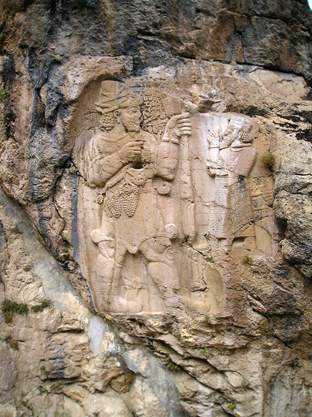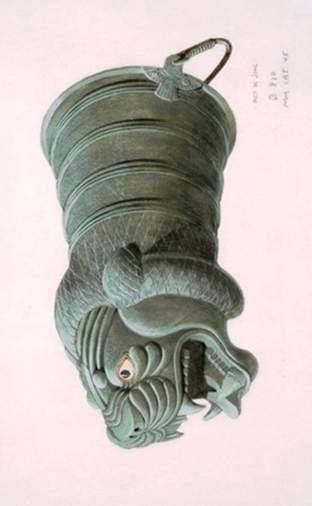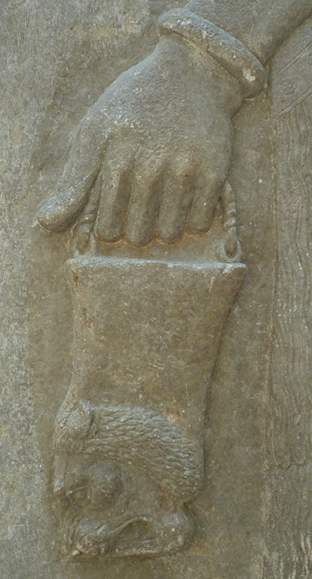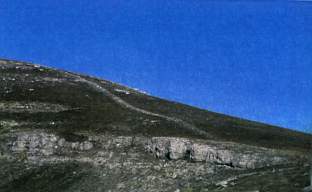Tabal and Phrygia: problem neighbours in the West
By the end of the 8th century BC, most of the "Neo-Hittite" kingdoms had been incorporated into the Assyrian Empire. Tabal was the only notable exception, and attempts to bring it to heel resulted in Assyrian contacts with Phrygia's ruler Midas.
The many kings of Tabal

The Assyrian sources mention the inner Anatolian region of Tabal as soon as military activities begin in the Taurus mountain range PGP west of the Euphrates PGP under Shalmaneser III (858-824 BC), reporting the submission of 24 kings of Tabal: clearly, this was a politically very fragmented territory. When Tiglath-pileser III (744-727 BC) re-asserted Assyrian influence in the region after the defeat of Urartu in 743 BC, Tabal was still split into several independent principalities but they were all sizeable enough to merit the use of the title of king for their rulers, at a time when the Assyrians had developed a more nuanced political vocabulary that no longer used this term for every monarch they encountered (cf. the essay on the Medes). "Tabal" was now used as a designation for one specific kingdom (in the Kayseri region), for this kingdom's capital (SAA 1 250: "the city of Tabal") as well as a blanket label for all the states in the general region. What precisely the Assyrians deemed gave them this joint identity is unclear, but in practice it took the shape not of political unity but of shared cultural traditions that are best demonstrated by the numerous Luwian inscriptions and rock reliefs found in the Western Taurus.
Tabal is employed as a blanket designation in an Assyrian administrative note written sometime between 743 and 738 BC, which lists the tribute payments of nine kings of Tabal (SAA 11 30), including mules, horses and alabaster. This archival text is one of the earliest in the Nineveh archives but how it found its way there is obscure. Perhaps this can be linked to the continuing interest that the region of Tabal held for Sargon II (721-705 BC), and later his successors. Three of the rulers mentioned in Tiglath-pileser's memorandum can be identified with rulers known from his inscriptions or local monuments in the Luwian language and script: Ašhittu (also Ušhittu) = Askwisis of Atuna, Tuatti = Tuwatis of Bit-Purutaš/Tabal and Urbala'a = Warpalawas of Tuhana (who was still active under Sargon II). These countries, and two of their rulers, are mentioned among Tiglath-pileser's vassals for the years 738 and 732 (Tiglath-pileser III 15 1 and parallels): Tabal (now ruled by Tuwatis's son Wasusarmas = Assyrian Uassurme), Atuna and Tuhana (still ruled by Askwisis and Warpalawas, respectively) are listed alongside the kingdoms of Ištunda and Hubišna.
Tuhana is the best known of the Tabalean principalities. Its capital of the same name can be safely identified with the Hellenistic, Roman and Byzantine city of Tyana whose ruins lie in the modern Turkish village of Kemerhisar, south of Niğde, where a stela of king Warpalawas was found in 1860. Rock monuments in nearby Ivriz and Bulgarmaden mention this king of Tuhana, the latter as the overlord of a local ruler. Finds of Luwian inscriptions suggest the region of Kayseri as the location of Bit-Purutaš/Tabal; the site of Kululu, where monuments of a number of kings of Tabal have been found, is the most likely to correspond to its capital.

The turncoat king of Cilicia and mighty Midas of Phrygia
Just south of Tabal lie the fertile coastal plains of Çukurova, ancient Cilicia. This used to be the kingdom of Hiyawa (Assyrian Que PGP ) with its capital city Adanawa, an Assyrian client state, until its last king Warikas (Assyrian Urikki), previously a loyal servant of the empire, freed himself from the Assyrian yoke. This resulted in his country's invasion and its incorporation as the Assyrian province of Que, either during the poorly documented reign of Shalmaneser V (726-722 BC) or at the very beginning of the rule of Sargon II. By rare chance, Warikas's transformation from steadfast vassal to self-assured sovereign is documented in his own inscriptions from Çineköy and Karatepe, written both in Luwian hieroglyphs and the Phoenician alphabet - a key source for the decipherment of Luwian.

Warikas's change of heart may be connected to the increasing influence of the western kingdom of Phrygia with its capital city Gordion. The Assyrians called Phrygia Mušku, using a name that first appeared as a designation for a people in the Assyrian sources in the 12th and 11th centuries BC. At that time, the Mušku people were attested as infiltrating and attempting to settle in the Upper Tigris PGP region and the Khabur PGP Triangle. Whether there is any factual connection with the later Mušku in central Anatolia remains unclear, as one must bear in mind the well established Assyrian practice of recycling ancient toponyms and gentilics to designate new locations and people.
At the time of Sargon, Mušku certainly referred to the kingdom of Midas, famous from Greek historiography and legend as the first non-Greek to have made a dedicatory gift at Delphi (Herodotus) and as the richest man on earth. The Great Tumulus of Gordion was long thought to be his burial mound (hence it was called MM = Midas Mound by the excavators) but the dendrochronological analysis of the wooden beams used to cover the burial chamber has shown that it was constructed already around 740 BC. The tumulus is therefore the burial monument of one of Midas's predecessors and its rich finds demonstrate that already before his reign there were contacts with Assyria, although these are not attested in the written sources. In particular, the bronze vessels used for drinking wine at the deceased's funeral and subsequently buried with him attest to the shared elite culture: like privileged Assyrians all over the empire, the people of Gordion used animal-headed buckets to serve wine, and so-called omphalos bowls to drink it from, during large feasts.
But despite sharing culinary and aesthetic tastes, Assyria and Phrygia were on bad terms. Although there are no relevant sources prior to Sargon's reign, his own inscriptions describe Midas as having long been a thorn in the empire's side, having never submitted to Sargon's predecessors and refusing diplomatic contacts. In 715 BC, Sargon's army conquered some fortresses in western Que that Midas of Phrygia had taken "very long ago", indicating that the king must have been in power for some time. This campaign resulted in an Assyrian foray deep into Phrygia but did not stop Midas from his continuing intervention in Que and Tabal.
A son-in-law's ambition and an unexpected friendship
Sargon had decided to back Bit-Purutaš/Tabal in its claim of sovereignty over the other Tabalean principalities. Already Tiglath-pileser had replaced the previous royal clan with Hulli, "the son of a nobody", after Wasusarmas had failed to pay tribute. When Hulli's son Ambaris succeeded him, Sargon gave him his own daughter in marriage and, as her dowry, doubled the size of his kingdom. An administrative note which lists precious jewellery given to diplomats for a range of countries, including Ekron PGP , Bet-Ammana PGP (Biblical Ammon) and Gubla PGP (Byblos), also mentions a diplomatic mission from Tabal that received especially rich gifts, and this text may well date to this harmonious period (SAA 7 58).
Ambaris's ambitions certainly made him worthy of a match with an Assyrian princess, but that his goal turned out to be expanding his territories at Assyria's expense instead of furthering the empire's interests in central Anatolia must have come as a nasty surprise to Sargon. When the bulk of the Assyrian army was occupied far away in Iran in 713 BC, the wayward son-in-law revealed his true objectives: he allied with Midas of Phrygia and Rusa of Urartu as well as the local Tabalean rulers in an attempt to invade Que. Yet Assyrian revenge came swiftly and the invasion of Ambaris's kingdom resulted in the capture of the king, his family and the nobles of his country, who were all taken to Assyria, and in the annexation of Tabal as an Assyrian province. However, the creation of this province only further escalated the situation and Assyria now found itself at war with assorted Tabalean principalities and Phrygia, and moreover increasingly on the losing side. Despite huge investments in the protection of the new border, including the fortification of Til-Garimmu (modern Gürün) and the construction of the so-called Cappadocian Wall, the province of Tabal was lost in 711 BC, never to be retaken.

No wonder that Sargon was ecstatic with joy when out of the blue Midas sent a diplomatic delegation to establish peace between Assyria and Phrygia, as documented in his letter to his governor in Que (SAA 1 1 = SAA 19 152): "The Phrygian has given us his word and become our ally!". Why Midas did so remains entirely unclear but is likely the result of factors beyond the actions of the Assyrian Empire, which at that time had reverted to border raids against Phrygia. The official Assyrian line, as documented in Sargon's inscriptions, was that Midas sent his embassy in 709 BC prompted by admiration and fear after Sargon had subdued Babylonia. However that may be, the new friendship between Assyria and Phrygia was bad news for the rulers of Tabal. As Sargon put it to his governor of Que: "What can all the kings of Tabal do henceforth? You will press them from this side and the Phrygian from that side so that (in no time) you will snap your belt on them. Thanks to my gods Aššur, Šamaš, Bel and Nabû, this land has now been trodden under your feet!"
But although Phrygia ceased its intervention in Tabal and Que (emerging only much later, in the reign of Esarhaddon (680-669 BC), once again as an enemy to Assyrian interests in the Malatya region: SAA 4 1), the situation in Tabal was not resolved. In 705 BC, Sargon personally led an army into battle at his former border fortress of Til-Garimmu, but instead of establishing Assyrian supremacy once and for all, the encounter was lost and resulted in Sargon's death - and shockingly, the loss of his body which could not receive a burial, a sacrilege that was later seen to haunt his descendants and his kingdom.
Tabaleans in the Assyrian Empire
Sargon's successor Sennacherib (704-681 BC) sent troops against Til-Garimmu in 695 BC, probably in order to avenge his father's death there. Later on, Iškallû the Tabalean and his people emerged as enemies of Assyria in a number of Esarhaddon's oracle queries (SAA 4 9, 10, 11, 14, 16). Given the problematic relations between Assyria and Tabal, it may come as a surprise to find that Tabalayu "Man from Tabal" was a popular personal name in 7th century Assyria. Most bearers of this name were clearly of Assyrian origin and at least some of significant social standing, such as "Tabalayu son of Bel-Harran-ahu-uṣur, whom the king, my lord (= Esarhaddon), promoted to the rank of cohort commander" (SAA 16 115). What qualities the Assyrians who chose this name for their sons associated with people from Tabal remains unclear but they were certainly positive - despite the fact that Tabal was at best an uneasy ally and more often than not an outright enemy of Assyria.
Other bearers of the name may have actually been from Tabal and given the name to replace their Anatolian names when they reached the Mesopotamian lowlands as slaves, professionally imported by merchants. A letter to Sargon (SAA 15 268) attests to the fact that such actions could happen despite the empire's interests, as an imperial official informs the king how he managed to retrieve 180 Assyrians and Tabaleans who had been illegally sold in Babylonia. Whenever Assyria and Tabal were allied, trafficking Tabaleans would have been outlawed. But when there was no treaty in place no such protection existed, and a sale contract from the reign of Assurbanipal (668-c. 630 BC) documents how the merchant Adda-rapa sold the Tabalean slave Kamabani to a military commander (SAA 14 91).
A great many Tabaleans reached the Assyrian Empire as deportees, especially after Ambaris's betrayal: Sargon had people from Tabal resettled in modern day Iran, in the province of Parsua PGP (SAA 15 54), from where many of them subsequently fled to the kingdom of Mannea PGP . And by the reign of Esarhaddon, there were so many women from Tabal settled in Babylon that an official petition was dispatched to the king to extend the traditional privileged status of Babylonian citizens also to their Tabalean (as well as Aramean PGP and Elamite PGP ) wives (SAA 18 158).
Further reading:
Digital Gordion [http://sites.museum.upenn.edu/gordion/].
Lanfranchi, 'The Luwian-Phoenician bilinguals of ÇINEKÖY and KARATEPE', 2007.
Melville, 'Kings of Tabal: Politics, Competition, and Conflict in a Contested Periphery', 2010.
Muscarella, 'Relations between Phrygia and Assyria in the 8th Century B.C.', 1998.
Postgate and Hawkins, 'Tribute from Tabal', 1988.
Weeden, 'Tuwati and Wasusarma: imitating the behaviour of Assyria', 2010.
Yamada, 'The city of Togarma', 2006.
Content last modified: 11 Feb 2013.
Karen Radner
Karen Radner, 'Tabal and Phrygia: problem neighbours in the West', Assyrian empire builders, University College London, 2013 [http://www.ucl.ac.uk/sargon/essentials/countries/tabalandphrygia/]